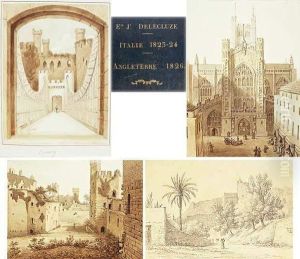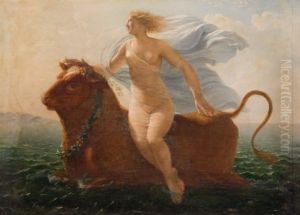Etienne Jean Delecluze Paintings
Étienne Jean Delécluze, born on February 22, 1781, in Paris, France, was a notable French painter, critic, and writer, deeply embedded in the artistic and intellectual currents of his time. His life spanned a period of significant upheaval and transformation in France, witnessing the French Revolution, the Napoleonic era, and the Restoration period. Delécluze's contributions to art and criticism were shaped by these tumultuous times, reflecting a keen insight into the evolving nature of French art and society.
Delécluze received his early training in the neoclassical tradition, which was dominant in French art at the turn of the 19th century. He studied under Jacques-Louis David, one of the most influential neoclassical painters of his time. This education grounded Delécluze in the principles of clarity, harmony, and moral seriousness, which would inform his later work as an artist and critic. Despite the promise he showed in his early years, Delécluze gradually shifted his focus from painting to writing, becoming one of the most respected art critics of his era.
As a critic, Delécluze championed the neoclassical ideals of his mentor David, while also engaging with the emerging Romantic movement, which sought to break from the strictures of neoclassicism in favor of emotion, individualism, and the sublime. His writings provide a vital insight into the artistic debates of the 19th century, embodying the tension between tradition and innovation that defined the period. Delécluze's most significant written work, 'Louis David, son école et son temps,' published in 1855, is not only a biography of his teacher but also a critical examination of the era, offering invaluable perspectives on the art and politics of post-revolutionary France.
Throughout his career, Delécluze maintained a commitment to the principles of clarity, order, and moral responsibility in art. He viewed these qualities as essential to the social and political regeneration of France, a belief that was reflected in his criticisms of works he saw as lacking in these respects. Despite his conservative leanings, Delécluze's engagement with the Romantic movement showed his openness to new ideas and his recognition of the need for art to evolve in response to changing times.
Delécluze's legacy is that of a bridge between two worlds: the neoclassical tradition he inherited and the new Romantic sensibilities he critiqued yet engaged with. His writings remain an essential resource for understanding the complex interplay of art, politics, and society in 19th-century France. Delécluze died on June 12, 1863, in Paris, leaving behind a body of work that continues to inform and inspire discussions on the nature and purpose of art.



![Album De 72 Vues D'auvergne, Executees Lors Du Voyage De 1821 [ ; 72 Views Of Auvergne ; Pen And Brown Ink, Wash Drawing, Lead Pencil]](https://www.niceartgallery.com/imgs/531418/s/etienne-jean-delecluze-album-de-72-vues-dauvergne-executees-lors-du-voyage-de-1821-72-views-of-auvergne-pen-and-brown-ink-wash-drawing-lead-pencil-4f546bba.jpg)

